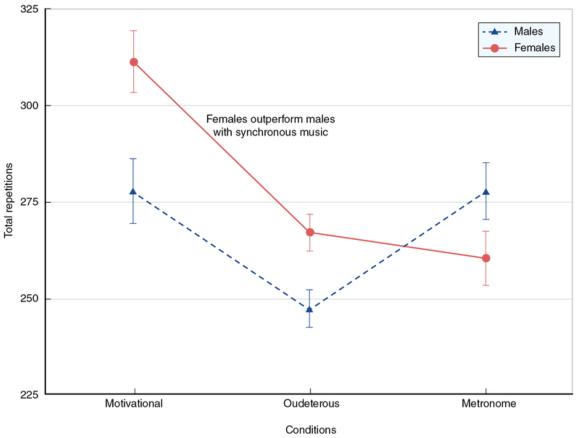The role of music in circuit training: Includes a sample playlist
This is an excerpt from Applying Music in Exercise and Sport by Costas I Karageorghis.
Circuit Training
Circuit training has grown considerably in popularity recently because it is an intense workout that can deliver relatively fast results in anaerobic endurance, muscle tone, and cardiorespiratory fitness. As the name circuit suggests, exercises and activities are organized in a circular formation; people exercise at each station for a set period (e.g., 25 seconds) before recovering for a set period (e.g., 20 seconds) and moving to the next station during the recovery. Once all of the stations have been completed (i.e., the circuit is completed), there is a longer period of recovery (normally two to five minutes). A typical workout consists of three or four circuits of 15 to 20 stations.
Circuit training is a hybrid fitness activity that includes muscular endurance, strength, mobility, plyometric, and speed components. Some instructors include coordination activities (e.g., skipping drills over plastic hurdles) to encourage participants to think while under physical stress. Given the repetitive and almost regimented nature of a circuit, people generally love to have music playing in the background. Even highly-trained participants express a preference for music. The activity is usually performed to asynchronous music, although lab-based research showed that coordinating circuit exercises with music in a synchronous manner particularly benefitted women in terms of the number of repetitions completed and how positive they felt (see figure 5.1 for performance data) (Karageorghis et al., 2010).

Gender differences in circuit training performance accompanied by synchronous music (motivational and oudeterous) and a metronome control.
Adapted from Psychology of Sport and Exercise 11(6), C.I. Karageorghis, D.L. Priest, L.S. Williams, R.M. Hirani, K.M. Lannon, and B.J. Bates, "Ergogenic and psychological effects of synchronous music during circuit-type exercise," 551-559, 2010, with permission from Elsevier.
Interestingly, the men in this research appeared to derive no performance benefit from synchronous music when the two music conditions (motivational and oudeterous) were compared to a bleeping metronome that served as a control. In explaining their findings, the authors reflected on the experiences males and females have with music during their formative years. They explained that girls are more likely to engage in movement to music-based activities and demonstrate a greater desire to engage in dance-related activity (Karageorghis et al., 2010). The findings also showed that women were, on the whole, more adept than their male counterparts at keeping in sync with the musical beat. Despite the potential benefits for women that this study demonstrates, the mix of activities in a real-life circuit and their physical demands means that the use of asynchronous music generally works best.
There are opportunities for synchronization during parts of a circuit, but this is often done on an ad hoc basis. For example, if an exerciser is performing bench dips, the background music is playing at 140 bpm, and her dipping rate is 35 reps per minute, she can either flex or extend the elbow joint with each two beats of music in 4/4 time to sync with it. There are musical ways to boost a circuits class. First, the music should be motivational and uplifting (see chapter 2 and the discussion of the BMRI-3 in chapter 3) and in a tempo range of 120 to 145 bpm. Second, the lower end of that tempo range should be used for the first circuit and gradually be built up toward the top end of the range for the final circuit, when the class needs the most stimulation. Taking this principle a step further, music may not be used at all for the first circuit and introduced in the second circuit. Third, a soundtrack for a circuits class can punctuate work and recovery periods. This can be done by having periods of silence for the recovery periods to signal when people need to stop and move to the next station, or by including bleeps on the soundtrack - perhaps a high-pitched bleep to start and a low-pitched bleep to stop.
As an unassuming undergraduate, my first scientific research into the effects of music on human performance entailed examining how stimulative and sedative music programs influenced the number of repetitions performed. The stimulative music produced superior performance levels when compared to sedative music and a no-music control (Karageorghis, 1991).Since that time, I have used music for a Monday night circuits class at my university. During the last 25 years, I have compiled many playlists (at least one a term) and have often asked participants for selections that I subsequently incorporate. For table 5.6, I have trawled through these playlists from the last quarter century to produce my all-time circuits playlist. Each mini-set (i.e., tracks for a single circuit) uses music from a distinct musical era to give the playlist greater coherence.

Discover the role music plays in Zumba, spinning, yoga, and more in Applying Music in Exercise and Sport.
More Excerpts From Applying Music in Exercise and SportSHOP

Get the latest insights with regular newsletters, plus periodic product information and special insider offers.
JOIN NOW


